 |
| Armstrong's Missing Picture |
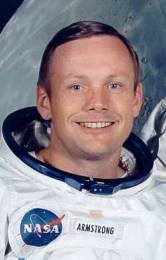 |
| After a sample of the moon's soil, one of the major objectives of the first moon walk should have been the securing of an image of Armstrong on the moon's surface for posterity. During the two and a quarter hours that Armstrong was on the moon every opportunity to capture his image in quality photographs should have been taken. Aldrin was on the moon for a little over one hour and thirty minutes and apart from the deployment of the early ALSEP, his other objective should have been to record Armstrong during his own activities. |
| After a few observations of the surface he placed his left boot onto the moon with the words, "That's one small step for man, one giant leap for mankind". After testing his mobility and taking a few photographs he proceeded onto the first major goal of those first few moments of a human being on another world, collecting a piece of the moon. |
 |
| From the window of the lunar module, this 16mm image was captured by the DAC just after Armstrong had collected the contingency return sample. After testing his balance, his first priority was to grab a sample of lunar rock and soil in case an emergency forced the moon walk to be cut short. Note the Lunar Module thruster to the right and Armstrong's shadow to the left. |
 |
| It is rare for any image of an astronaut on the moon to show their face, but to see one of Armstrong's is quite amazing. Here his face and Snoopy helmet are clearly visible as he safely deposits the contingency return sample into his leg pocket. |
 |
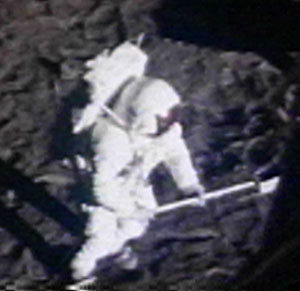 |
| As he begins to spend most of his time out of the shadow of the Lunar Module, Armstrong lowers his visor to protect his eyes from the blinding glare of the sun. Note the handle of the scoop he used to gather the lunar sample with lying on the surface at his feet. |
| Here we can see that Armstrong has lowered the side visor of his helmet to provide further protection from the sun. Note that he is now holding a device to enable him to collect more samples for return to Earth. |
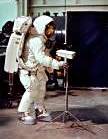 |
| On the moon Armstrong moves the TV camera to a better position to cover the moon walk. It is an image similar to the one above taken during training. Note the TV wire leaving a trail of disturbed soil, later on in the moon walk Aldrin had to warn Armstrong to watch his feet when he caught them up in this wire. |
| Soon Armstrong was joined on the moon's surface by Buzz Aldrin and they performed a couple of important ceremonies. |
| In these frames from the DAC, Armstrong and Aldrin plant the U.S. flag into the lunar soil. |
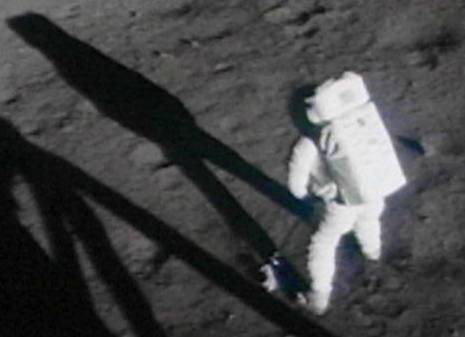 |
| A long handled scoop was used to gather a small sample; when he had obtained this Armstrong detached the collecting bag from the handle and safely deposited it into the leg pocket of his spacesuit. |
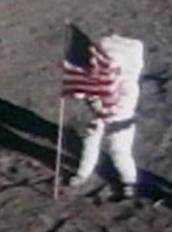 |
| Armstrong unfurls the Stars and Stripes on the lunar surface |
| Armstrong taking the picture on the left of Buzz Aldrin standing next to the U.S. flag. Note the TV camera to Armstrongs left. |
| This is the image we have of Aldrin next to the U.S. flag, compare it to the best image we have of Armstrong with the flag and the difference in quality is obvious. |
| Armstrong seen trying to get the U.S. flag to remain standing in the hard lunar regolith. |
 |
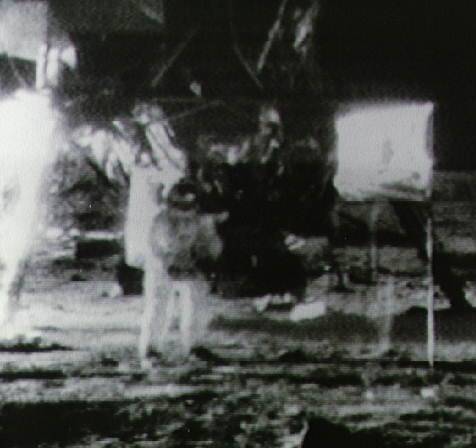 |
| Armstrong stands in front of the Lunar Module Eagle facing the U.S. flag as he listens to the President during the unrehearsed telephone call in this TV image. |
| Armstrong, on the right, with Aldrin in another TV image showing them unveiling the plaque on the front landing leg of the Lunar Module. Note Armstrong has the Hasselblad still photography camera attached to his EMU. |
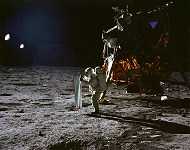 |
| During the TV broadcast, Armstrong is seen photographing Aldrin deploying the Solar Wind Collector. The photograph he took can be seen above and it is a stark illustration between the quality of images recording the moment between Armstrong and Aldrin. |
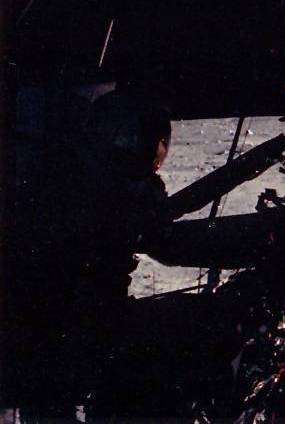 |
| AS-11-40-5886, the one shown below on the right, is the best image of Armstrong on the moon. |
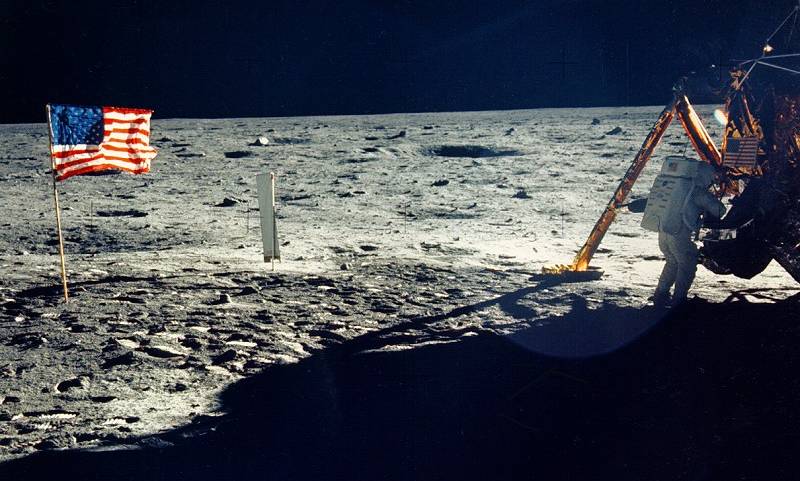 |
| Believe it or not this is the only clear photograph showing the whole body of the first man on the moon during that historic moon walk of Apollo 11. Armstrong is at the MESA and he is in the image only because he happened to be standing by Eagle during the time Aldrin was taking a panoramic sequence with the stills camera. It is frustrating to think how easy it would have been for Aldrin to take a couple of moments out from his planned LEVA tasks and ask Armstrong to take a few steps to his right and stand by the U.S. flag, thus capturing the kind of image below. |
| July 20th 1969 the first man on the moon Neil Armstrong beside the U.S. flag, the image that never was! |
 |
| Finally, the most famous picture of Armstrong on the moon, here he is, barely visible, reflected in the gold visor of his fellow moonwalker Buzz Aldrin. Note the Lunar Module is on the right and to the left the small square against the black sky is the U.S. flag. |
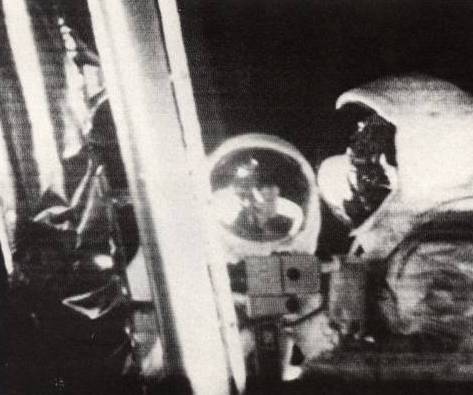 |
| Back To Index |
 |
 |
 |
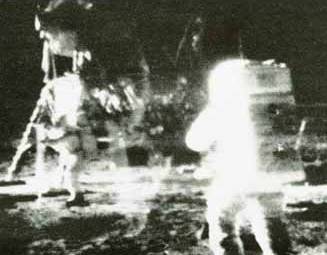 |
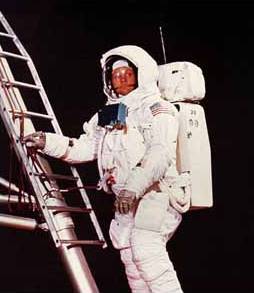 |
 |
| On July 20th 1969, Neil Armstrong descended the nine rungs on the front landing leg of the Lunar Module Eagle. |
| The TV inside the MESA captured the moment Armstrong stepped onto the moon, its a poor image compared to the same view taken from training on the right but the TV was the only way of capturing the first step. |
 |
| AS11-40-5894 |
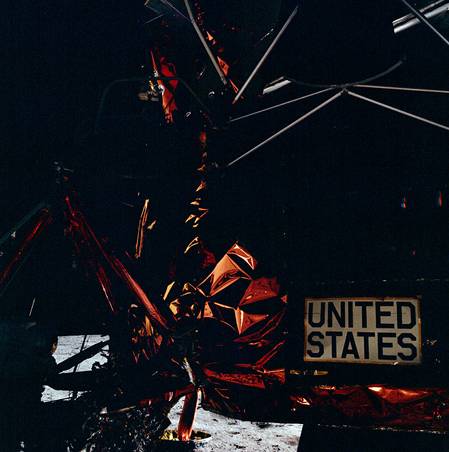 |
 |
 |
 |
| AS11-40-5916 |
 |
 |
| During the training for the first moonwalk, Armstrong is seen in practically the same pose as the one on the right taken on the moon, another example of what might have been. |
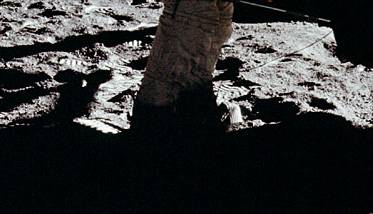 |
| AS11-40-5895 |
| To the best of anyone's knowledge, there are only six photographs that contain Armstrong on the surface of the moon. |
| The underexposed photo on the left, AS11-40-5894, shows Armstrong in the shadow of the Lunar Module working at the MESA. |
| The photo on the left, AS11-40-5895, shows the ladder and the lower part of Armstrong's spacesuit, as can be seen in the detail below. |
| Close-up, Armstrong can be seen, his gold visor is down and his communications antenna shines in the sunlight. |
| AS-40-5896 |
| AS11-40-5896, shows the forward landing pad of Eagle and Armstrong's legs below the knees in the background |
| AS11-40-5916 shows Armstrong's right leg and boot and the back of his PLSS, he appeared in this photo by accident as Aldrin photographed the Solar Wind Collector experiment. The clarity and detail of the image is another example of what could have been possible. What is evident from AS11-40-5894/5895-5896 and 5916 is the fact that Armstrong was not the intended subject of the photograph. Aldrin was just carrying out his photographic duties and Armstrong, or for the most part only part of him, appeared in the image by accident. |
| Unfortunately all we have to record the first man to step onto the moon are a few photographs, that don't do the occasion justice, the grainy black and white TV images and the images recorded on the Data Acquistion Camera (DAC) that are not very sharp. Below are a few of the best images of Armstrong from that first moon walk. |
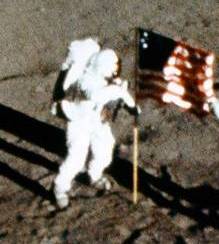 |
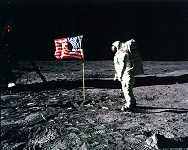 |
 |
| Copyright 2001-2009 by Robert M. Southall |
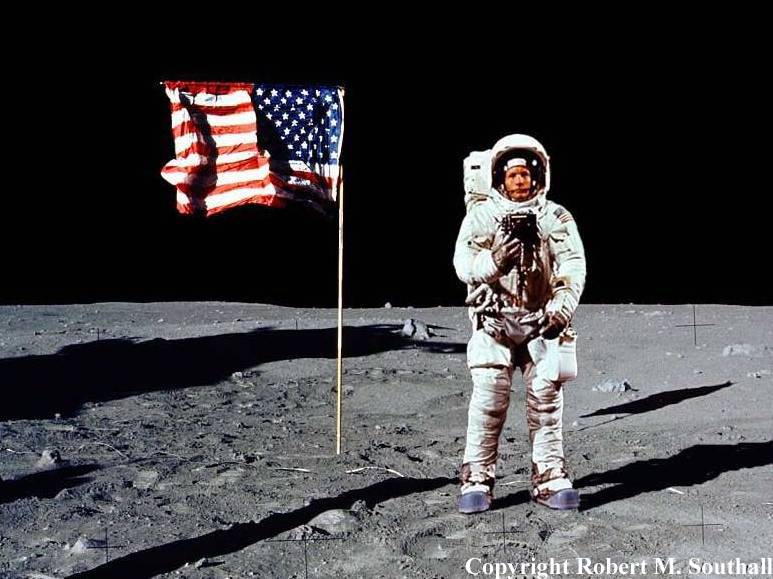 |